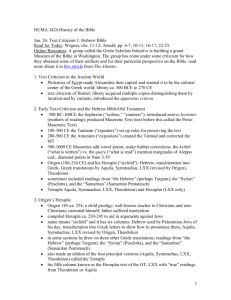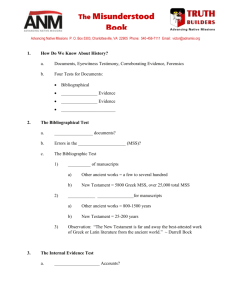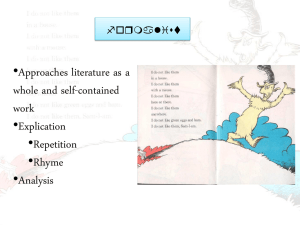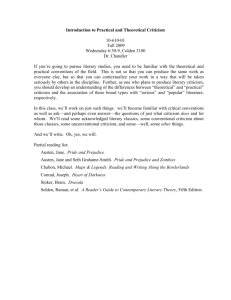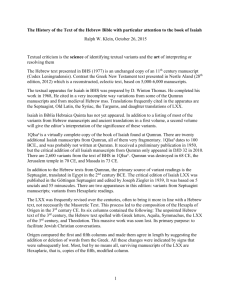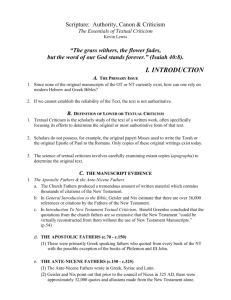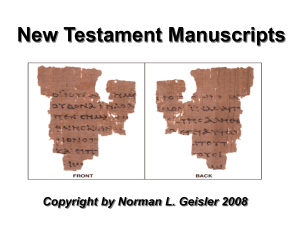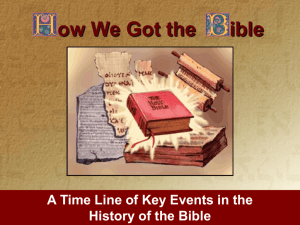May 26: The First Critical Editions (Jerome to
advertisement
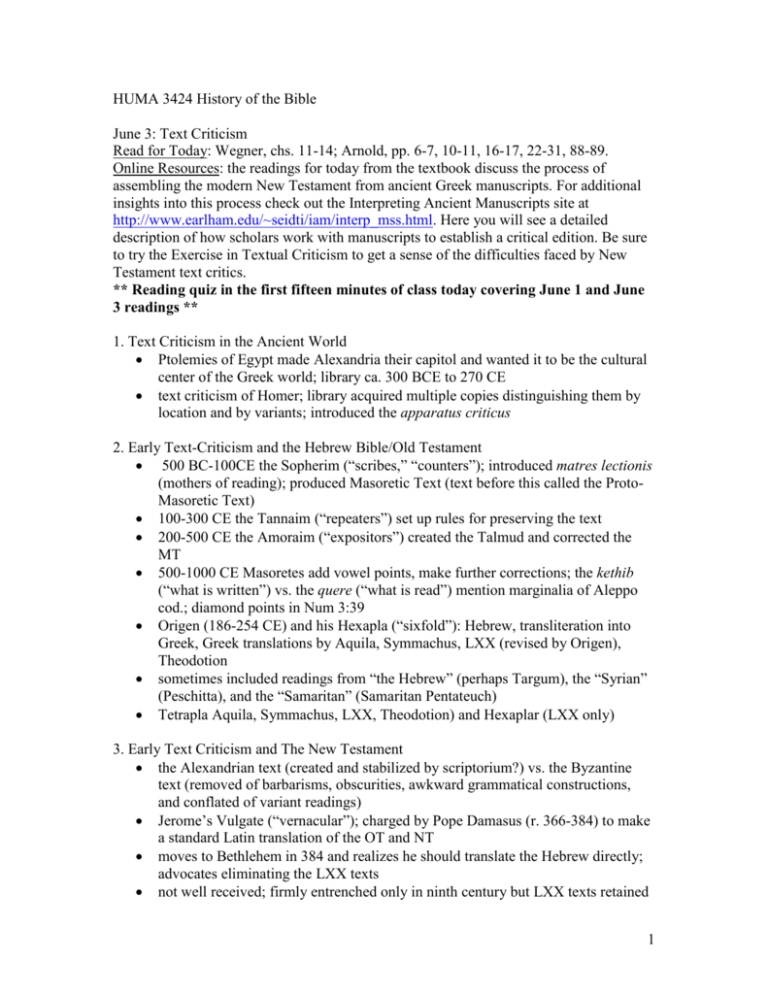
HUMA 3424 History of the Bible June 3: Text Criticism Read for Today: Wegner, chs. 11-14; Arnold, pp. 6-7, 10-11, 16-17, 22-31, 88-89. Online Resources: the readings for today from the textbook discuss the process of assembling the modern New Testament from ancient Greek manuscripts. For additional insights into this process check out the Interpreting Ancient Manuscripts site at http://www.earlham.edu/~seidti/iam/interp_mss.html. Here you will see a detailed description of how scholars work with manuscripts to establish a critical edition. Be sure to try the Exercise in Textual Criticism to get a sense of the difficulties faced by New Testament text critics. ** Reading quiz in the first fifteen minutes of class today covering June 1 and June 3 readings ** 1. Text Criticism in the Ancient World Ptolemies of Egypt made Alexandria their capitol and wanted it to be the cultural center of the Greek world; library ca. 300 BCE to 270 CE text criticism of Homer; library acquired multiple copies distinguishing them by location and by variants; introduced the apparatus criticus 2. Early Text-Criticism and the Hebrew Bible/Old Testament 500 BC-100CE the Sopherim (“scribes,” “counters”); introduced matres lectionis (mothers of reading); produced Masoretic Text (text before this called the ProtoMasoretic Text) 100-300 CE the Tannaim (“repeaters”) set up rules for preserving the text 200-500 CE the Amoraim (“expositors”) created the Talmud and corrected the MT 500-1000 CE Masoretes add vowel points, make further corrections; the kethib (“what is written”) vs. the quere (“what is read”) mention marginalia of Aleppo cod.; diamond points in Num 3:39 Origen (186-254 CE) and his Hexapla (“sixfold”): Hebrew, transliteration into Greek, Greek translations by Aquila, Symmachus, LXX (revised by Origen), Theodotion sometimes included readings from “the Hebrew” (perhaps Targum), the “Syrian” (Peschitta), and the “Samaritan” (Samaritan Pentateuch) Tetrapla Aquila, Symmachus, LXX, Theodotion) and Hexaplar (LXX only) 3. Early Text Criticism and The New Testament the Alexandrian text (created and stabilized by scriptorium?) vs. the Byzantine text (removed of barbarisms, obscurities, awkward grammatical constructions, and conflated of variant readings) Jerome’s Vulgate (“vernacular”); charged by Pope Damasus (r. 366-384) to make a standard Latin translation of the OT and NT moves to Bethlehem in 384 and realizes he should translate the Hebrew directly; advocates eliminating the LXX texts not well received; firmly entrenched only in ninth century but LXX texts retained 1 4. Modern Text Criticism Textual criticism: the science and art that seeks to determine the most reliable wording of a text principles: o manuscripts must be weighed, not counted. o Determine the reading that would most likely give rise to others. o The more difficult reading is preferable o The shorter reading is preferable o Determine which reading is more appropriate in its context Hebrew Bible/Old Testament sources: o MT manuscripts: Codex Leningradensis (dated 1008), Aleppo Codex (930 very similar to Leningrad), Codex Cairensis (895), Oriental 4445 (London Codex; ca. 950); 3000 MT Mss in total o Ancient Translations or Recensions: LXX, SP, Old Latin Text, Latin Vulgate, Syriac Peshitta, Targums (Aramaic) o silver amulets (7th cent. BCE) o Nash Papyrus (2nd cent. BCE - 1st cent. CE) o Dead Sea Scrolls (3rd cent. BCE - 1st cent. CE) o Masada manuscripts (ca. 73 CE) o Severus Scroll (1st cent. CE) New Testament o 5400 mss of NT passages and books in Greek; versions in other languages (Syriac, Latin, Coptic) and quotations by early church fathers 5. Changes to the Text of the Bible confusion of letters (Gen 10:4 Dodanim; 1 Chron 1:7), homophony, metathesis, harmonization, fusion/fission haplography: omission of text due to homoioteleuton or homoioarkton (1 Sam 14:41; Gen 4:8; 1 John 2:23) other omissions (1 Sam 13:1; Eph 1:1) dittography: repetition of a section (Mark 3:13) intentional changes: Mark 1:2-3; Gen 18:22; Luke 2:41, 43 additions: glosses (e.g., Gen 7:6; John 5:4), the additional endings Mark (after 16:8), the Woman Caught in Adutery (John 8:1-11), Jesus Sweats Blood (Luke 22:44) 6. Exercise in Textual Criticism (handout in class) 2
